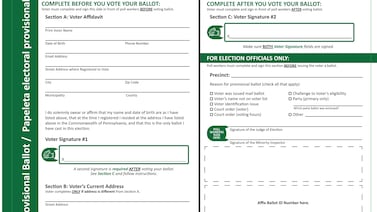This article is part of a yearlong reporting project focused on redistricting and gerrymandering in Pennsylvania. It is made possible by the support of Spotlight PA members and Votebeat, a project focused on election integrity and voting access.
HARRISBURG — The Pennsylvania House has advanced a new congressional map that nonpartisan analysts say has a clear Republican advantage, but its fate remains unclear as a court-mandated deadline looms.
The map, which will help determine the balance of power in Washington, passed with support from all but two of the chamber’s Republicans and from none of the Democrats. It now goes to the state Senate for consideration.
While the proposal fulfills four basic fairness criteria embraced by the Pennsylvania Supreme Court, redistricting reform groups said it does not reflect the partisan makeup of the state — a sticking point for Gov. Tom Wolf, who has final say over the map.
Adam Podowitz-Thomas of the Princeton Gerrymandering Project, a nonpartisan organization that analyzes redistricting plans across the country, said nearly all metrics that social scientists use to analyze the fairness of a map show Pennsylvania’s current proposal gives Republicans an advantage.
“I don’t believe that Gov. Wolf is going to end up signing,” he said. “I think that the partisan bias is too clearly in favor of the Republicans.”
If Wolf and the legislature do not agree on a final plan by Jan. 30, Commonwealth Court said it will take over the process as part of an ongoing lawsuit and select a map from those submitted by parties involved in the case.
The map advanced Wednesday was selected by Republicans on the House State Government Committee and based on a plan drawn by Amanda Holt, a former Republican Lehigh County commissioner and noted redistricting activist.
The initial map, however, was adjusted after several Republicans on the committee complained that their counties were split. The amended map advanced out of committee to the full House without public feedback.
Though the map creates compact, contiguous districts with equal population and minimal county splits — requirements outlined by the state Supreme Court in a previous redistricting ruling — it fails to measure up in partisan fairness, according to several nonpartisan analyses.
Partisan fairness is determined using a combination of metrics that measure how the map treats each party. Most metrics use past election data to see if the proposed map’s projected results would enhance a party’s power. Analysts also look at the difference in projected seat share between the parties even if each party received 50% of the votes, among other metrics.
Rep. Seth Grove, a York County Republican who has championed the map, emphasized that it was initially drawn by a person who is not a lawmaker and fulfills the requirements embraced by the state’s high court. He noted that no lawmakers, including Democrats, offered amendments to the map.
“The citizen mapmaker developed it without partisan data. We updated it without using partisan data,” Grove said. “I think this is a map the citizens can be proud of.”
Grove said on the House floor that, of the map’s 17 districts, eight would favor Republicans, eight would favor Democrats, and one would be a toss-up.
Those numbers come from Dave’s Redistricting, a nonpartisan website that uploads and analyzes district maps, and represent projections based on past results from a single election.
Podowitz-Thomas said using one election’s results “isn’t really a valid way to look at anticipated outcomes in the future.”
Using a composite of election results, Dave’s Redistricting has categorized five districts as likely Democratic and seven as Republican. The other five are classified as competitive but favor Republicans. The Princeton Gerrymandering Project’s analysis is very similar, Podowitz-Thomas said.
Democrats on Wednesday said they were shut out of the process and had no insight into why Holt’s map was chosen. Rep. Scott Conklin (D., Centre) criticized what he called a lack of transparency throughout the process.
“I don’t know, was it a big hat they picked it out of? Was it a group that got together? I don’t know,” said Conklin, who serves with Grove as minority chair of the committee that advanced the map.
While Wolf has criticized the map as “heavily skewed,” he has thus far declined to say definitively whether he would veto it in its current form.
“My role is either to sign or veto whatever the General Assembly sends me,” Wolf told reporters in December. He added that he wouldn’t negotiate over what the map looks like but would sign off on one that matches the principles of his own redistricting advisory council.
States redraw their congressional map every 10 years after the census to account for population changes. Because of Pennsylvania’s sluggish population growth relative to other states, it will lose one of its 18 congressional districts.
Even before the process formally began last year, many redistricting observers predicted that Wolf and the GOP-controlled legislature would fail to reach a compromise and the map would end up in court. That increasingly appears to be where things are headed.
Two lawsuits targeting the map — one from a group of residents who live in population-dense areas, the other from mathematicians and scientists seeking a “data-driven” process — were filed in Commonwealth Court in December.
Learn more about our partner Spotlight PA, sign up for a newsletter, and support its local journalism.







